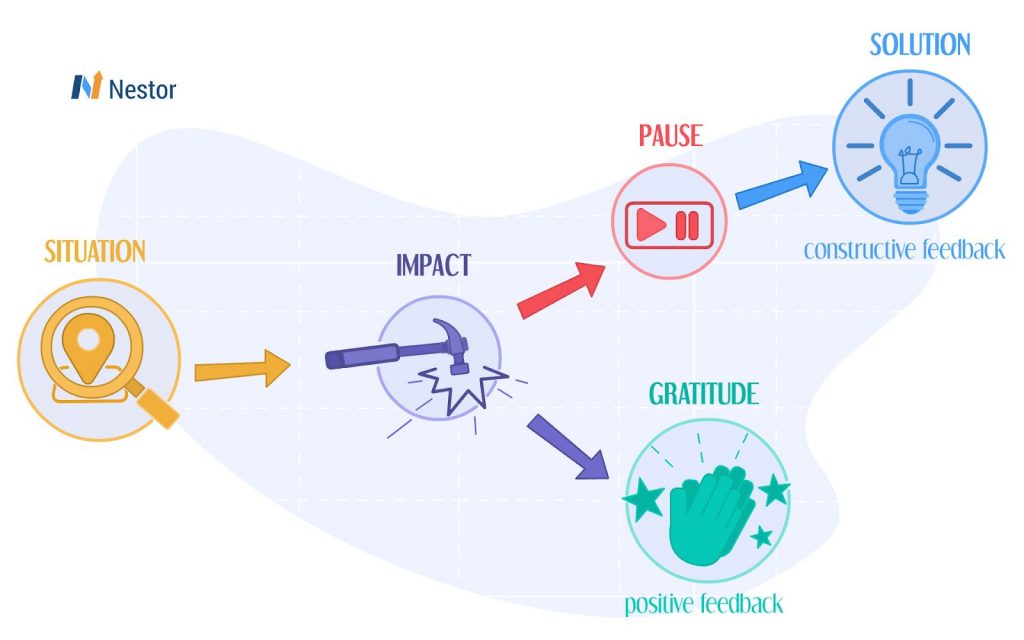Do You Speak Positive and Constructive Feedback?
10 min read

Feedback is the process of sharing what’s your perception about somebody’s performance and how you think they should improve. This is one of the reasons why feedback is a controversial concept. Some love it, some get chills when they hear about it. Some don’t give it proper attention and importance. That’s why it is crucial to learn how to give positive and constructive feedback.
Make a difference by learning how to give and receive positive and constructive feedback to empower your people and fuel your business success.
In it’s March-April 2019 magazine, HBR published an article that criticized the way the process of feedback is done in organizations, The Feedback Fallacy, written by Marcus Buckingham and Ashley Goodall. In the article the authors are stating strong and pertinent arguments on what is wrong with the feedback process. They are questioning three theories that are generally considered as truths and mention how they actually might affect the feedback process:
- theory of the source of truth – we as humans are processing and understanding information through our own values, beliefs, education, background and experiences. Hence, when we share our opinion, it is biased by our perception of the world. This is called the idiosyncratic rater effect, making us “unreliable raters of other human beings”.
- theory of learning – the main conclusion being that focusing on what people are doing wrong impairs the learning process.
- theory of excellence – again, it is idiosyncratic, being relative, different and individual to each of us.
Hence, we thrive and grow “only when people who know us and care about us tell us what they experience and what they feel, and in particular when they see something within us that really works.”
Done right, continuous feedback is a powerful tool to enhance performance and create a culture of development. As a result, it should be used as a positive instrument to help you and other people thrive, instead of being perceived as a personal attack on one’s character.
Make the experience more positive and powerful by focusing on what your people can improve instead of what they are doing wrong.
The art of giving feedback
Positive and constructive feedback is a valuable gift you are making to your colleagues. Building rapport and trustful relationships with your colleagues will facilitate the proper reception of the message you want heard.
Let’s dive in into several best practices that will make a big difference in your next feedback sessions:
Build rapport
Gain your people’s trust and build trustworthy relationships. People tend to be more open and listen more to what people who genuinely care about them have to say. Be curious about your people’s values, beliefs, personalities and try to compassionately understand their behaviors. When in doubt, ask. The most dangerous and toxic thing you can do is assume somebody’s reasons for doing or saying something.
When in doubt, ask. The most dangerous and toxic thing you can do is assume somebody’s reasons for doing or saying something.
Identify what your people’s preferences are in terms of feedback. How frequently do they need it?
We at Nestor encourage continuous and on the spot feedback. However, one of the beauties of people is that we are different and something that is working for you will not work for your colleagues, and vice versa. And that’s ok.
Ask for permission to give feedback. Make sure it’s a good moment for the other person to receive feedback. Receiving feedback in an inappropriate state of the mind can cause more damage than good.
Prepare your positive and constructive feedback
Before the conversation itself, gather your thoughts and take notes. Make sure you are providing valuable insights. Think of clear examples to illustrate your point. Explore the facts and use specific examples to support your point.
Think of what added value your feedback brings into the table. What blind spots might your input unveil?
What blind spots might your feedback unveil?
Be aware of the wording
Avoid generalizations. Words like “always”, “never” are most probably inaccurate and tell half of the story (if any). They generate distortion, blame and are in general words to avoid, especially in a feedback situation. Be specific and keep your details linked to concrete actions, tasks and behaviors.
Focus on expressing the way you felt or what you experienced when a situation happened. Remember, it’s your perception of the event, it’s how you see it, what effect it has on you and how you choose to react, based on your inner and individual programming.
Therefore, you want to focus on compassionate, nonviolent communication, avoiding any interpretation or blaming.
Marshall B. Rosenberg developed a four-steps process for achieving nonviolent communication aiming to support building partnerships and unravel conflicts amongst people, societies and relationships.
The process of nonviolent communication
Start with concrete actions that you observe and that affect your wellbeing or significantly differ from the agreed expectations of the outcome. Separate your observations from evaluations. When combining observations with evaluations people have the tendency to hear criticism and hence, become resistant to what you are saying
Follow by expressing how you feel in relation to your above observations.
Next, state your needs, values, wishes etc. that support your feeling mentioned above.
Last but not least, honestly express concrete actions you are requesting to be taken to improve your life/condition. Use a clear, positive, solution and action oriented language when stating your request. Avoid formulating your request as a demand. When somebody hears a demand there are two possibilities: either they will obey or rebel against. Neither of the two are constructive. When expressing a request, be empathetic with the other person and make it a collaborative process.
Here’s the “magic” formula Rosenberg is proposing:
When […], I feel […], because I need […]. As a result, I would love now to […]
For example, one of your colleagues is not responsive and is not regularly updating on his work. Now you identified an observation. Stop here. How does it make you feel? What’s the need behind that feeling? What actions do you need to take to boost your condition?
Here’s an example of how to formulate your feedback: “When I don’t hear from you, I feel anxious, because I need more clarity on the progress to know where the project might encounter difficulties. As a result, I would like to have daily standups to discuss project’s progress, bottlenecks and successes. What are your thoughts on that?”
Focus on your tone
Often how we say something matters more than what we say. Use a supportive, approachable and informal tone. Offer honest support and suggestions on ways to overcome obstacles and challenges. Create a comfortable environment by bringing onto the table some personal examples and anecdotes.
Delivering positive and constructive feedback is a collaborative process. So practice active listening. Give time to process and digest information and create space for follow up questions from the other person.
You are not a judge
When put in the situation of providing constructive feedback, remember that you are not a judge. You do not hold the absolute truth. No one does. Unquestionable, you’ll bring an interesting perspective or experience. But that doesn’t mean you know exactly what the other person should do. So be curious and humble, provide useful suggestions and leave the other person to balance and choose what to do with that information.
Next time when preparing for giving positive and constructive feedback, if you start feeling that you are judging, think what of your own needs and values are screaming to be expressed?
What of your own needs and values are screaming to be expressed?
Foster a forward focus
Even if you are put into the situation to give negative feedback, keep a forward looking mindset. You cannot get things undone. But you might have a greater impact by helping to identify solutions that minimize the consequences and create awareness and urgency to improve.
Avoid also the sandwich feedback trap. It is awfully confusing and when put in between two layers of positives, it makes it easy to forget the constructive feedback on the negative impact. Instead, focus on stating clear, direct and descriptive points. Help identify solutions by supporting and guiding your people in developing a doable action plan.
Be aware of the biases
Be aware of some biases that might interfere with your thoughts when preparing for your feedback session. Knowing them will guide you to identify what really needs to be said and what can bring value. Here are just a couple of them:
- Affinity bias – we tend to send positive responses to people who we think are similar to us.
- Halo bias – admiring all of a person’s actions just because of their past achievements.
- Perception bias – the tendency to form stereotypes and assumptions on specific groups.
- Confirmation bias – looking for evidence to support our initial perceptions, by disregarding the contradictory information.
When preparing for a feedback session, question your observations. Think how much of it might be a bias and how much is your real perception?
I received feedback. Now what?
First of all, be grateful! Positive and constructive feedback is a gift. It’s someone’s time and effort towards your development and growth.
Now it’s your responsibility to digest it and figure out how much of it is truly about you. Take a step back and constructively digest the received feedback without obsessing about it. What matters the most now is what you choose to do with it.
Be curious and develop a forward looking action plan to address all the insights you choose to work on. Be aware of your own needs. Do you need more time to process the information? Do you need support in a specific area? Be authentic and open minded.
Cultivate a growth mindset and start separating opinions and facts. Ask the other person for clarifications and support when needed.
What do you choose to do with the feedback you just received?
Final thoughts
On a final note, be authentic, vulnerable and learn how your people prefer their feedback being served.
Encourage and enhance positive behaviour by taking a moment to celebrate when your colleague did something that you appreciate as a good way of doing things. By stating this on the spot, your colleague will be able to assess what exactly happened and how he/she can create more of this in the future.
Express your appreciation to celebrate and not to manipulate. Your only intention is to celebrate the fact that your colleague just enriched your and your team’s life.
Be kind with yourself. It’s a learning process and you’ll get better at it with every feedback session. Ask for feedback when giving feedback. This will also help you become more aware and focus on what’s working and how you can do better next time.
Lead by example and ask your people “What can I do better?” – encouraging positive approach instead of the negative one “What am I doing wrong?”.
Create a habit out of it. Give feedback, ask for feedback and reiterate with the learnings in mind.

Focus on your intention rather than the words. Change your perspective from negative and positive feedback to positive and developmental feedback and make it constructive in both cases.










